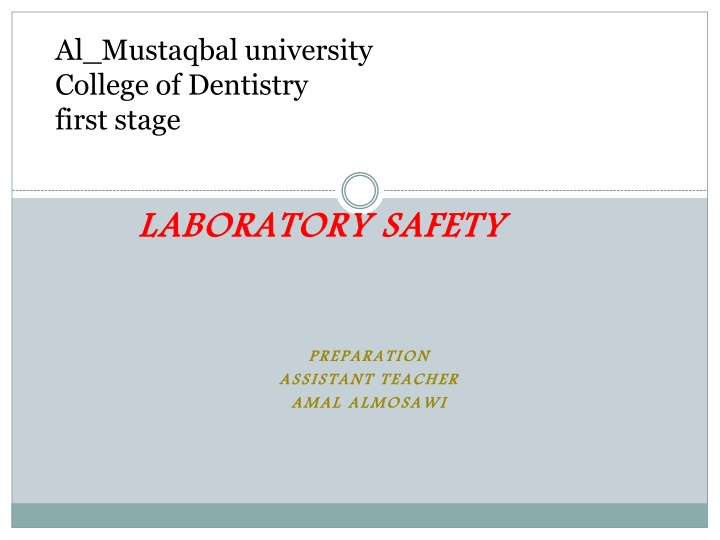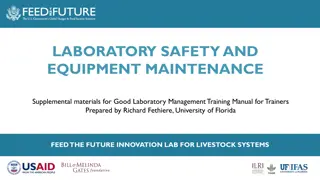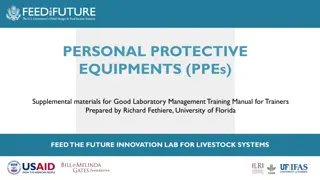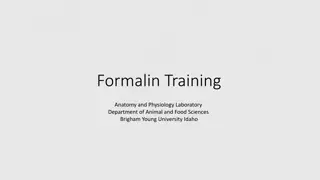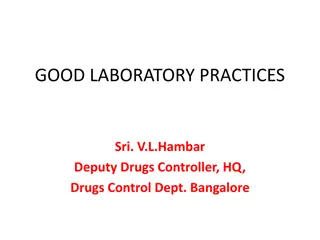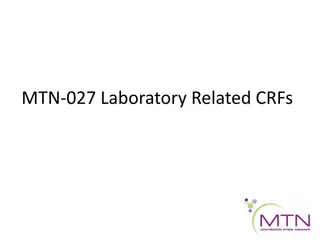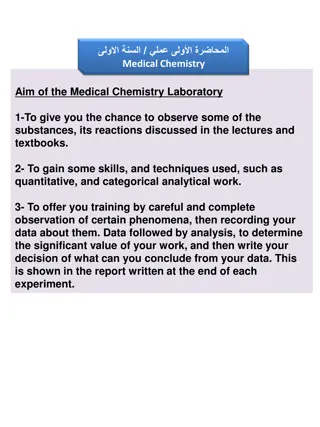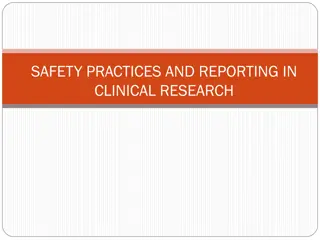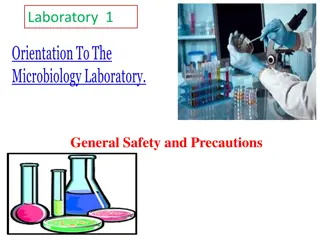Laboratory Safety Practices
Laboratory safety practices are crucial for preventing accidents and protecting individuals working in laboratory settings. These practices involve various measures such as appropriate facilities, equipment, chemical management, waste handling, and safety training. Risks in laboratories include exposure to hazardous chemicals, high pressures, temperatures, radiation, and biohazards. Adhering to safety rules, wearing protective equipment, and following protocols can help mitigate these risks and ensure a safe working environment.
Download Presentation

Please find below an Image/Link to download the presentation.
The content on the website is provided AS IS for your information and personal use only. It may not be sold, licensed, or shared on other websites without obtaining consent from the author.If you encounter any issues during the download, it is possible that the publisher has removed the file from their server.
You are allowed to download the files provided on this website for personal or commercial use, subject to the condition that they are used lawfully. All files are the property of their respective owners.
The content on the website is provided AS IS for your information and personal use only. It may not be sold, licensed, or shared on other websites without obtaining consent from the author.
E N D
Presentation Transcript
Al_Mustaqbal university College of Dentistry first stage LABORATORY SAFETY LABORATORY SAFETY PREPARATION ASSISTANT TEACHER AMAL PREPARATION ASSISTANT TEACHER AMAL ALMOSAWI ALMOSAWI
What is laboratory safety? Laboratory safety practices include appropriate facilities and equipment, adequate training, personal protective equipment, chemical management, standard operating procedures, waste handling, signage, proper laboratory practices and safe working conditions.
Many laboratories contain significant risks, and the prevention of laboratory accidents requires great care and constant vigilance. Examples of risk factors include high voltages, high and low pressures and temperatures, corrosive and toxic chemicals and chemical vapours, radiation, and biohazards including infective organisms and their toxins. Measures to protect against laboratory accidents include safety training and enforcement of laboratory safety policies, safety review of experimental designs, the use of personal protective equipment, and the use of the buddy system for particularly risky operations fire, explosions,
Laboratory safety rules 1-Follow the instructions. 2-Keep snacks out of the lab. 3- Don't sniff the chemicals. 4-Dispose of waste properly. 5- Identify safety equipment. 6-Think safety first. 7-Dress for the lab. 8- Don't play the mad scientist.
What are the basic lab safety rules? 1-Know emergency exit routes. 2-Avoid skin and eye contact with all chemicals. 3- Minimize all chemical exposures. 4- No horseplay will be tolerated.
What is laboratory safety and why is it important? A laboratory poses potential risks due to exposure to corrosive and toxic materials, flammable solvents, high pressure gases, explosive chemicals and dangerous microbes. A little care and adherence to prescribed safety guidelines will help avoid laboratory mishaps.
What is safety rules? Definition. A principle or regulation governing actions, procedures or devices intended to lower the occurrence or risk of injury, loss and danger to persons, property or the environment
Chemical hazards Laboratory chemicals include cancer-causing agents (carcinogens), toxins (e.g., those affecting the liver, kidney, and nervous system), irritants, corrosives, sensitizers, as well as agents that act on the blood system or damage the lungs, skin, eyes, or mucous membranes.
Biological hazards These hazards are present in various sources throughout the laboratory such as blood and body fluids, culture specimens, body tissue and cadavers, and laboratory animals, as well as other workers.
Physical hazards and others Besides exposure to chemicals and biological agents, laboratory workers can also be exposed to a number of physical hazards. Some of the common physical hazards that they may encounter include the following: ergonomic, ionizing radiation, non-ionizing radiation and noise hazards.
